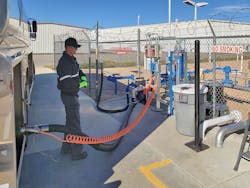The National Fire Protection Association (NFPA) has updated regulatory requirements for aviation fill stands (fuel racks) and refuelers (tank trucks) to improve safety for operators, reduce risks of environmental release like fuel spills, and eliminate liability incidents such as fires or human injury.
While 407 covers many facets of fuel operations, the focus of this article is on three aspects. The current requirements include:
- Two-level overfill protection on refuelers and fill stands (positive shutdown of pumping)
- Bonding of refuelers to the fill stand to prevent sparks or electric arcs in a potentially combustible atmosphere
- An operational deadman switch to ensure constant human monitoring of the refueler and fill stand during the fueling process
Facility upgrades might be required to meet these standards with a completion deadline of June 2023. Depending on the location of the aviation facility, an appropriate “authority having jurisdiction,” will be in contact with operators to verify regulatory compliance. Various organizations administer commercial fuel operations and provide oversight of facilities – the Federal Aviation Administration (FAA), local fire marshals, airport authorities, state weights and measures and even insurance companies.
The NFPA began developing aviation fuel standards for airports beginning in 1966. There have been 15 revisions to the specific regulatory rules and language, assessing adverse incidents and the application of evolving technologies to address safety, efficiency and potential environmental issues.
With the tremendous growth of flight resources for travelers in the last 50 years, the NFPA assembles a “technical committee” to review avenues to pursue improvements for the fueling process while keeping investment dollars and cost of ownership in mind. These committees are established every five years and are composed of interested parties and industry representatives.
There is a formal, professional process and is outlined at – NFPA.org.
“The NFPA standards development process encourages public participation in the development of its standards. All NFPA standards are revised and updated every three to five years, in revision cycles that begin twice each year. Normally a standards cycle takes approximately two years to complete. Each revision cycle proceeds according to a published schedule, which includes final dates for each stage in the standards development process. The four fundamental steps in the NFPA standards development process are: public input, public comment, NFPA technical meeting (tech session), standards council action (appeals and issuance of standard),” the outline reads.
Challenges
For airports needing to take action, the situation at hand presents a unique set of challenges including budget, scheduling and optimum plan for compliance.
Regulatory Confusion
One of the most pervasive hurdles in this process is a general misunderstanding of the regulations and erroneous speculations on upgrade budgets. This has led to some operators to resist or delay moving forward with renovations. The specific actions and investments to reach compliance with NFPA 407 can be confusing. There can be a wide assortment of installed infrastructure on the fill stand (tanks, piping, hoses, pumps, meter/registers, bonding cable and deadman system). Also, most airports have an array of refuelers, often built by different manufacturers with a range of model years.
What’s more, NFPA 407 does not apply to fuel servicing of hydrant systems, flying boats or amphibious aircraft on water, in-flight fueling, filling or draining aircraft fuel tanks for maintenance, or analysis of fuel quality.
The 407 document is not meant to be used as the primary specifications for the design or construction of aviation fuel facilities, as other regulatory requirements are in play – such as the American Petroleum Institute (API) and Environmental Protection Agency (EPA). Other underground or above ground storage tank regulations/requirements may apply.
Various Upgrade Paths
Many fill stands currently have deadman systems and bonding cables. In these instances, operators need only to address the overfill portion of the fill stand requirements by adding an overfill monitor to communicate to an electronic sensor added to the refueler. Although adding just the overfill equipment seems straight forward, contractors with experience should be employed as electrical connections, product piping layout and flow control should be reviewed thoroughly. These systems can be complicated when considered as a whole.
Aviation refuelers are typically single-compartment tanks that currently have “jet level sensors” (single-level overfill). To achieve two-level overfill, an electronic sensor needs to be installed with a cable and socket to connect to an overfill monitor on the fill stand. Some of these refuelers do not have an existing hole in the top of the tank or man lid to mount the sensor. In these situations, a new lid must be added to the refueler to accommodate the sensor.
For extensive renovations or new build facilities, operators should consider all solutions. There are systems available that have the capabilities to achieve two-level overfill, bonding and deadman operations in one single-rack monitor device. The monitor is connected to the refueler with a cable and can interface to a tank with two electronic sensors or one electronic sensor and a (hydraulic) jet level sensor to meet all regulations. Other options are an audible alarm and an output signal to other emergency systems.
Contractor Capability
If an operator delays, it may be difficult to find a contractor that is willing or capable of performing the work on both the refueler and the fill stand. Most companies are dedicated to either refuelers or fill stands, averting a one-source “turn-key” solution. Be advised that a refueler usually cannot be driven off an airport to a tank shop for the required work. With the June 2023 deadline looming, available contractors could be in tight supply.
Summary
NFPA 407 was formulated by aviation industry stakeholders to improve safety, and operational efficiencies for transferring avgas and jet fuel from storage tanks to aviation refuelers. Multiple options are available to aviation facilities engaged in upgrading to comply with the new NFPA 407 regulations. Operators should consider short- and long-term operational objectives when planning the upgrades. Operators should seek contractors that will provide a consultative approach based on existing infrastructure and refueler equipment capabilities.
David Zumbaugh has been in the oil business for decades and has been with Scully Signal Company for the last eight years. Recently, he has worked with commercial air carriers, FBOs and design/build firms to clarify pathways to comply with NFPA 407. He emphasizes there are a variety of options to satisfy the NFPA 407 requirements.
About the Author

David Zumbaugh
Regional Sales Manager, Scully Signal Company
David Zumbaugh has been in the oil business for decades and has been with Scully Signal Company for the last eight years. Recently, he has worked with commercial air carriers, FBOs and design/build firms to clarify pathways to comply with NFPA 407. He emphasizes there are a variety of options to satisfy the NFPA 407 requirements.
